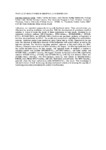Use este identificador para citar ou linkar para este item:
http://www.alice.cnptia.embrapa.br/alice/handle/doc/932724Registro completo de metadados
| Campo DC | Valor | Idioma |
|---|---|---|
| dc.contributor.author | COSTA, G. R. | pt_BR |
| dc.contributor.author | SOUSA, T. C. de | pt_BR |
| dc.contributor.author | MANDARINO, J. M. G. | pt_BR |
| dc.contributor.author | LEITE, R. S. | pt_BR |
| dc.contributor.author | LABANCA, R. A. | pt_BR |
| dc.date.accessioned | 2012-08-31T11:11:11Z | pt_BR |
| dc.date.available | 2012-08-31T11:11:11Z | pt_BR |
| dc.date.created | 2012-08-31 | pt_BR |
| dc.date.issued | 2012 | pt_BR |
| dc.identifier.citation | Foz do iguaçu: IUFoST, 2012. | pt_BR |
| dc.identifier.uri | http://www.alice.cnptia.embrapa.br/alice/handle/doc/932724 | pt_BR |
| dc.description | Isoflavones are important compounds in soy with functional claims. Their concentrations are influenced by growing conditions and genetics. With the development of genetically modified varieties is crucial to know the levels of these substances in new seeds. Analyzed in six transgenic soybean cultivars (BRS-FavoritaRR, BRS-ValiosaRR, BRSMG-850GRR, BRSMG-811CRR, BRSMG-750SRR and BRSMG-740SRR) isoflavones (genistein, daidzein, and glycitein in their four chemical forms) by HPLC. The results were compared in mg/100g of dry and defatted samples. Statistical analysis was performed using Turkey test (p <0.05). Observed in the raw grain, the absence of detectable amounts of the isoflavones with acetyl radical, as well as the aglucone glycitein. The literature describes genistein aglycone as the most active and BRS-ValiosaRR showed a lower level and BRS-FavoritaRR the largest, not differing significantly from this variety BRSMG-750SRR for this analyte. The aglycone forms of daidzein is second in biological activity and varieties BRSMG-811CRR and BRS-ValiosaRR had lower grades and BRSMG 750SRR-and BRS-FavoritaRR the largest. The total isoflavones did not differ significantly between BRSMG-811CRR (413.86d) and BRSMG740-SRR (435.72d) but between these and BRSMG-750SRR (491.94c). The BRS-ValiosaRR (533.73b) was similar to BRSMG-850GRR (549.08b) but differed BRS-FavoritaRR (591.29a) that higher concentration. The BRS-FavoritaRR generally show the best performance while BRSMG-810CRR the worst. This knowledge is relevant in terms of both technology development (seed richest) and showing the quantity of food being consumed (considering the content of isoflavones). | pt_BR |
| dc.format | In: WORLD CONGRESS OF FOOD SCIENCE AND TECHNOLOGY, 16.; LATIN AMERICAN SEMINAR OF FOOD SCIENCE AND TECHNOLOGY, 17., 2012, Foz do Iguaçu. Addressing global food security and wellness through food science and technology: [proceedings]. Foz do Iguaçu: IUFoST, 2012. 1 CD-ROM. | pt_BR |
| dc.language.iso | eng | eng |
| dc.rights | openAccess | eng |
| dc.subject | Isoflavona | pt_BR |
| dc.title | Profile of isoflavones in genetically modified soy. | pt_BR |
| dc.type | Resumo em anais e proceedings | pt_BR |
| dc.date.updated | 2015-01-30T11:11:11Z | pt_BR |
| dc.subject.thesagro | Soja | pt_BR |
| dc.subject.thesagro | Tecnologia de alimento | pt_BR |
| dc.subject.thesagro | Planta transgênica | pt_BR |
| dc.subject.nalthesaurus | Soybeans | pt_BR |
| dc.subject.nalthesaurus | Food technology | pt_BR |
| dc.subject.nalthesaurus | Isoflavones | pt_BR |
| dc.subject.nalthesaurus | Transgenic plants | pt_BR |
| riaa.ainfo.id | 932724 | pt_BR |
| riaa.ainfo.lastupdate | 2015-01-30 | pt_BR |
| dc.contributor.institution | GABRIELA REZENDE COSTA, UFMG; THAÍSA CORRÊA DE SOUSA, UFMG; JOSE MARCOS GONTIJO MANDARINO, CNPSO; RODRIGO SANTOS LEITE, CNPSO; RENATA ADRIANA LABANCA, UFMG - Professora. | pt_BR |
| Aparece nas coleções: | Resumo em anais de congresso (CNPSO)  | |
Arquivos associados a este item:
| Arquivo | Descrição | Tamanho | Formato | |
|---|---|---|---|---|
| 06470.pdf | 49,2 kB | Adobe PDF |  Visualizar/Abrir |









